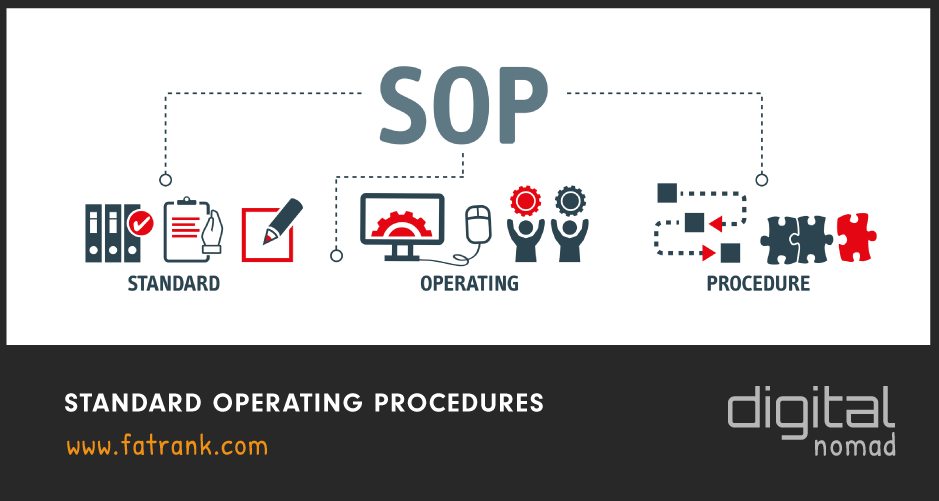
Standard Operating Procedures
If you want to effectively scale your business and workflow then Standard Operating Procedures need to be set up.
A standard operating procedure (SOP) is a set of step-by-step instructions compiled by an organization to help workers carry out complex routine operations.
SOPs aim to achieve efficiency, quality output and uniformity of performance while reducing miscommunication and failure to comply with industry regulations.
Contents
Why SOPs Are a Must?
As the tired old saying goes, there are tons of moving parts in a business or organization of any size.
Standard operating procedure documentation is important because it allows organizations to systematize their processes, keep all team members and other stakeholders on the same page at all times, and move forward in a singular, cohesive manner.
Often, the difference between a productive, successful business and a failing business is whether or not these systems are moving in conjunction with one another.
This can be the difference between a finely-tuned machine and one that regularly breaks down—and eventually falls apart.
For your organization to run like such a finely-tuned machine (and to avoid falling apart at the seams), your team members need to be on the same page at all times.
This is where a standard operating procedure comes into play.
What An SOP Should Achieve?
Too many businesses are people dependent when actually they should be systems dependent.
If a member of staff was ill tomorrow could another team member be able to take off where the other had left?
If not then you are building your whole company on quicksand and SOPs are needed to be implemented quickly.
A standard operating procedure (SOP) is a document that provides clear-cut directions and instructions as to how teams and members within an organization must go about completing certain processes.
Note that SOP documentation is much more involved than a simple procedural document. The main difference being that procedural documents are meant to provide a high-level overview of the process in question, while SOPs provide an “on-the-ground” explanation of what needs to happen to ensure a given process goes as planned.
Benefits To SOPs
The benefits of creating SOPs are endless.
Here are some reasons why we created better systems and SOPs within our agencies.
Ensures Consistency
Developing a standard operating procedure better enables your business to run like a finely-tuned machine.
A huge part of running “like a machine” is consistency.
Following SOP procedures ensure that your team will always know the right path to take and will always take this path when necessary.
An SOP makes both decisions and processes more automatic for your team at all times and removes the need for any guesswork.
Ensures Adherence to Best Company Practices
Creating a standard operating procedure better enables adherence to best practices regarding all company processes is not merely a suggestion, but a mandate.
The companies best practices should be defined by the entire team from the owners, managers to the technicians carrying out the work.
The best SOPs are when the technicians improve and evolve the systems further.
In involving team members from all departments and hierarchical tiers in the process of developing SOP, you can be sure that your team is always acting in the best interest of the company.
An SOP provides a clearly-drawn map to guide them along the way. This improves the chances of experiencing a positive outcome in a given situation, while also minimizing the chances of encountering any obstacles throughout the process.
Developing an SOP ensures your team knows the most efficient and effective way to go about a certain task. This means you’ll be expending fewer resources to experience optimal results, regardless of the task at hand.
Easier to Onboard and Train
In clearly defining standard operating procedures within your business, you’ll inherently make it easier to onboard and train your team members with regard to best practices in certain situations.
Since one of the goals of creating SOP is to leave no stone unturned in terms of contingent circumstances, you’ll have a better idea of what these potential circumstances are leaving you better prepared to train your employees as to how to navigate them.
In contrast, in not having clearly-defined SOPs in place, you run the risk of leaving your team uninformed and unprepared to handle certain challenges as they come about.
Standard Operating Procedures Examples
Here are our Standard Operating Procedures we need to effectively grow our SEO team:
Summary
Creating standard operating procedures is perhaps the best way to ensure your team puts their talents to maximum usage.
It allows your staff to be productive and effective in their position if given proper and explicit guidance.
With clear-cut, comprehensive standard operating procedures on-hand at all times, your team members will always know exactly what to do in any situation they face.
In turn, your organization’s productivity will all but certainly skyrocket.

About FatRank
Our aim to explain and educate from a basic level to an advanced on SEO and Social Media Marketing.
